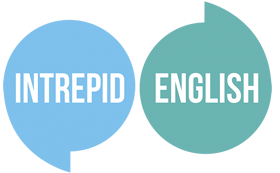This week on the Intrepid English Blog, we have something a little different for you. Today’s post is a special guest post from a fellow English teacher and friend of mine, Patrick. Patrick is an English teacher from Toronto, Canada currently residing in sunny Monterrey, Mexico. Patrick is an accent coach, online English teacher, and host of the English Out LOUD podcast. In fact, Patrick and I recently got together and had a really fun chat about all things podcasting, teaching online, and the differences between our accents. You can listen to that episode right here on the Intrepid English Podcast, or on Patrick’s English Out LOUD podcast.
I hope you enjoy today’s guest blog post! Stay tuned for more language and pronunciation tips coming soon from Patrick.
As an accent coach, I’m often asked by new students how long it will take to acquire an American accent, or if it’s even possible to get a full American accent? While I have yet to see a non-native English speaker develop a completely seamless American accent, I have seen countless students adapt essential English sounds to their natural speech, and ultimately a clear and confident American flow. Try a quick muscle memory exercise with me here. Really, I’m going to communicate to you, through this blog post, instructions on how to move your muscles, and you, as the reader, should follow these movements.
First, focus on the tip of your tongue. Notice where it is, and what it’s touching. Maybe the backs of your teeth, maybe the roof of your mouth, maybe your bottom teeth, or maybe it’s touching nothing at all.
Now, press the tip of your tongue to the backs of your top front teeth, then feel, from front to back, the roof of your mouth with the tip of your tongue. Notice the ridge of your hard palate as your tongue rolls back to the soft palate.
Finally, open your jaw. Feel how your tongue moves down with your jaw naturally when it opens. The synchronized movement of your jaw and tongue is your muscle memory. When your jaw goes down, your tongue tip moves with it, because that’s how they naturally move.
Obtaining an accent, of any sort, comes down to your ability to recognize the movements of your mouth muscles when speaking, and manipulate the muscle memory to make the sounds that you prefer.
I’m here to tell you that your language skills can go as far as you are willing to take them. Your accent is truly the one part of your speech that can be moulded to your own desire, and considering you’ll be using English for the rest of your life, why not play with it?
Book a trial lesson today and talk about your learning goals with an experienced English teacher. Say goodbye to boring English lessons! If you’re not sure what you want to learn, let your teacher choose from the range of English courses that have been designed to help our students to achieve their goals.
